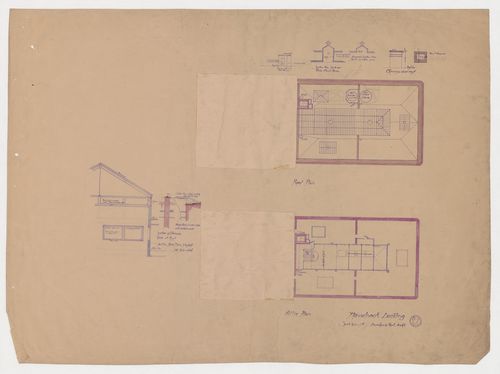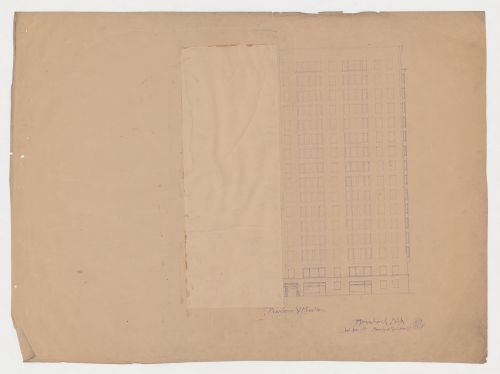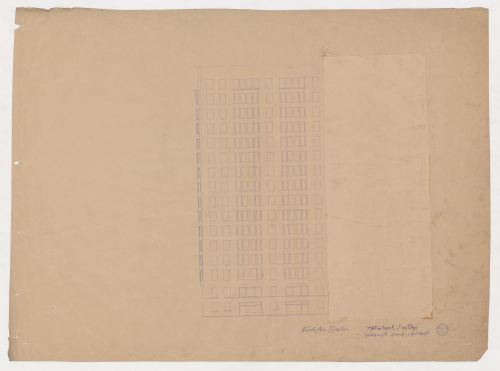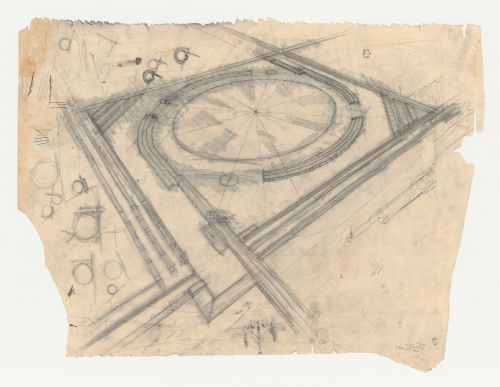DR1986:0767:256
Description:
- Twenty hectographs of the Monadnock Building were probably cut apart when the southern half, owned by Shepherd Brooks, became the Kearsarge Building in 1889 (DR1986:0767:120). The southern half of the building (DR1986:0767:466:001-042 and DR1986:0767:467:001-054) was cut out, leaving the northern half (DR1986:0767:048 - DR1986:0767:056, DR1986:0767:248 - DR1986:0767:257, and DR1986:0767:259). The hectographs were possibly divided so that two discrete sets of reprographic copies could be produced for the Monadnock and Kearsarge Buildings.
architecture
printed 1890-1892
Monadnock Building, Chicago: Attic and roof plans, section for the main skylight with plan and elevation for a chimney, partial sections through the division wall, elevation for the penthouse, and section for skylights
Actions:
DR1986:0767:256
Description:
- Twenty hectographs of the Monadnock Building were probably cut apart when the southern half, owned by Shepherd Brooks, became the Kearsarge Building in 1889 (DR1986:0767:120). The southern half of the building (DR1986:0767:466:001-042 and DR1986:0767:467:001-054) was cut out, leaving the northern half (DR1986:0767:048 - DR1986:0767:056, DR1986:0767:248 - DR1986:0767:257, and DR1986:0767:259). The hectographs were possibly divided so that two discrete sets of reprographic copies could be produced for the Monadnock and Kearsarge Buildings.
architecture
DR1986:0767:257
Description:
- Twenty hectographs of the Monadnock Building were probably cut apart when the southern half, owned by Shepherd Brooks, became the Kearsarge Building in 1889 (DR1986:0767:120). The southern half of the building (DR1986:0767:466:001-042 and DR1986:0767:467:001-054) was cut out, leaving the northern half (DR1986:0767:048 - DR1986:0767:056, DR1986:0767:248 - DR1986:0767:257, and DR1986:0767:259). The hectographs were possibly divided so that two discrete sets of reprographic copies could be produced for the Monadnock and Kearsarge Buildings.
architecture
printed 1890-1892
Monadnock Building, Chicago: Dearborn Street elevation
Actions:
DR1986:0767:257
Description:
- Twenty hectographs of the Monadnock Building were probably cut apart when the southern half, owned by Shepherd Brooks, became the Kearsarge Building in 1889 (DR1986:0767:120). The southern half of the building (DR1986:0767:466:001-042 and DR1986:0767:467:001-054) was cut out, leaving the northern half (DR1986:0767:048 - DR1986:0767:056, DR1986:0767:248 - DR1986:0767:257, and DR1986:0767:259). The hectographs were possibly divided so that two discrete sets of reprographic copies could be produced for the Monadnock and Kearsarge Buildings.
architecture
DR1986:0767:259
Description:
- Twenty hectographs of the Monadnock Building were probably cut apart when the southern half, owned by Shepherd Brooks, became the Kearsarge Building in 1889 (DR1986:0767:120). The southern half of the building (DR1986:0767:466:001-042 and DR1986:0767:467:001-054) was cut out, leaving the northern half (DR1986:0767:048 - DR1986:0767:056, DR1986:0767:248 - DR1986:0767:257, and DR1986:0767:259). The hectographs were possibly divided so that two discrete sets of reprographic copies could be produced for the Monadnock and Kearsarge Buildings.
architecture
printed 1890-1892
Monadnock Building, Chicago: Fourth Avenue elevation
Actions:
DR1986:0767:259
Description:
- Twenty hectographs of the Monadnock Building were probably cut apart when the southern half, owned by Shepherd Brooks, became the Kearsarge Building in 1889 (DR1986:0767:120). The southern half of the building (DR1986:0767:466:001-042 and DR1986:0767:467:001-054) was cut out, leaving the northern half (DR1986:0767:048 - DR1986:0767:056, DR1986:0767:248 - DR1986:0767:257, and DR1986:0767:259). The hectographs were possibly divided so that two discrete sets of reprographic copies could be produced for the Monadnock and Kearsarge Buildings.
architecture
Projet
Donmar
AP144.S2.D53
Description:
File documents the unexecuted conversion of the Donmar rehearsal studio in Covent Garden, London, England, United Kingdom into an experimental theatre and late night meeting place. The client was the Fun Palace Trust ("Cedric Price Supplement", 'Architectural Design', vol. 40, (October 1970), 515) and negotiations for the conversion were undertaken with Donald Albery of New Theatre and Donmar Productions Limited. Movable platforms, furniture, and fittings were designed so that various seating and performance areas of different sizes could be created to accommodate a wide range of activities and entertainment of an impromptu nature. Survey drawings show the Donmar rehearsal studio and environs. Drawings for the conversion include plans, sections, axonometric projections, cutaway axonometric drawings showing the interior layout from two points of view, and conceptual sketches and perspectives of interior spaces in use. Axonometric drawings for fittings and furniture show platforms, a small stage, a chair/table, and a "conversation box". A drawing examines the sightlines of the converted interior by showing human figures in relationship with the movable units. Amended floor plans and sections show variations for the interior layout. Material in this file was produced between 1963 and 1964. File contains design development drawings and textual records.
1963-1964
Donmar
Actions:
AP144.S2.D53
Description:
File documents the unexecuted conversion of the Donmar rehearsal studio in Covent Garden, London, England, United Kingdom into an experimental theatre and late night meeting place. The client was the Fun Palace Trust ("Cedric Price Supplement", 'Architectural Design', vol. 40, (October 1970), 515) and negotiations for the conversion were undertaken with Donald Albery of New Theatre and Donmar Productions Limited. Movable platforms, furniture, and fittings were designed so that various seating and performance areas of different sizes could be created to accommodate a wide range of activities and entertainment of an impromptu nature. Survey drawings show the Donmar rehearsal studio and environs. Drawings for the conversion include plans, sections, axonometric projections, cutaway axonometric drawings showing the interior layout from two points of view, and conceptual sketches and perspectives of interior spaces in use. Axonometric drawings for fittings and furniture show platforms, a small stage, a chair/table, and a "conversation box". A drawing examines the sightlines of the converted interior by showing human figures in relationship with the movable units. Amended floor plans and sections show variations for the interior layout. Material in this file was produced between 1963 and 1964. File contains design development drawings and textual records.
File 53
1963-1964
DR1987:0399
Description:
- This drawing is blackened with graphite on the verso so that the design could be transferred to another surface, in this case the submitted competition panel, DR1987:0359. There are drops of black watercolour and a series of black ink lines in the upper right corner. These media were used for the submitted panel and their presence here also suggests that this drawing was used in preparation of the submitted panel. There are a series of design sketches, along the left side and at the centre of the drawing, which appear to deal with the relationship of the airfield to hangars.
architecture
1929
Lehigh Airports Competition Entry: Bird's-eye perspective
Actions:
DR1987:0399
Description:
- This drawing is blackened with graphite on the verso so that the design could be transferred to another surface, in this case the submitted competition panel, DR1987:0359. There are drops of black watercolour and a series of black ink lines in the upper right corner. These media were used for the submitted panel and their presence here also suggests that this drawing was used in preparation of the submitted panel. There are a series of design sketches, along the left side and at the centre of the drawing, which appear to deal with the relationship of the airfield to hangars.
architecture
dessins
DR1986:0767:053
Description:
- Twenty hectographs of the Monadnock Building were probably cut apart when the southern half, owned by Shepherd Brooks, became the Kearsarge Building in 1889 (DR1986:0767:120). The southern half of the building (DR1986:0767:466:001-042 and DR1986:0767:467:001-054) was cut out, leaving the northern half (DR1986:0767:048 - DR1986:0767:056, DR1986:0767:248 - DR1986:0767:257, and DR1986:0767:259). The hectographs were possibly divided so that two discrete sets of reprographic copies could be produced for the Monadnock and Kearsarge Buildings.
architecture, ingénierie
printed after 1889
Monadnock Building, Chicago: Seventh and eighth floor framing plans
Actions:
DR1986:0767:053
Description:
- Twenty hectographs of the Monadnock Building were probably cut apart when the southern half, owned by Shepherd Brooks, became the Kearsarge Building in 1889 (DR1986:0767:120). The southern half of the building (DR1986:0767:466:001-042 and DR1986:0767:467:001-054) was cut out, leaving the northern half (DR1986:0767:048 - DR1986:0767:056, DR1986:0767:248 - DR1986:0767:257, and DR1986:0767:259). The hectographs were possibly divided so that two discrete sets of reprographic copies could be produced for the Monadnock and Kearsarge Buildings.
dessins
printed after 1889
architecture, ingénierie
dessins
DR1986:0767:054
Description:
- Twenty hectographs of the Monadnock Building were probably cut apart when the southern half, owned by Shepherd Brooks, became the Kearsarge Building in 1889 (DR1986:0767:120). The southern half of the building (DR1986:0767:466:001-042 and DR1986:0767:467:001-054) was cut out, leaving the northern half (DR1986:0767:048 - DR1986:0767:056, DR1986:0767:248 - DR1986:0767:257, and DR1986:0767:259). The hectographs were possibly divided so that two discrete sets of reprographic copies could be produced for the Monadnock and Kearsarge Buildings.
architecture, ingénierie
printed after 1889
Monadnock Building, Chicago: Fifth and sixth floor framing plans with details for plate, beam-to-girder connections and anchors, and a schedule for plates and anchors
Actions:
DR1986:0767:054
Description:
- Twenty hectographs of the Monadnock Building were probably cut apart when the southern half, owned by Shepherd Brooks, became the Kearsarge Building in 1889 (DR1986:0767:120). The southern half of the building (DR1986:0767:466:001-042 and DR1986:0767:467:001-054) was cut out, leaving the northern half (DR1986:0767:048 - DR1986:0767:056, DR1986:0767:248 - DR1986:0767:257, and DR1986:0767:259). The hectographs were possibly divided so that two discrete sets of reprographic copies could be produced for the Monadnock and Kearsarge Buildings.
dessins
printed after 1889
architecture, ingénierie
dessins
DR1986:0767:055
Description:
- Twenty hectographs of the Monadnock Building were probably cut apart when the southern half, owned by Shepherd Brooks, became the Kearsarge Building in 1889 (DR1986:0767:120). The southern half of the building (DR1986:0767:466:001-042 and DR1986:0767:467:001-054) was cut out, leaving the northern half (DR1986:0767:048 - DR1986:0767:056, DR1986:0767:248 - DR1986:0767:257, and DR1986:0767:259). The hectographs were possibly divided so that two discrete sets of reprographic copies could be produced for the Monadnock and Kearsarge Buildings.
architecture, ingénierie
printed after 1889
Monadnock Building, Chicago: Third and fourth floor framing plans with details for the beam connections
Actions:
DR1986:0767:055
Description:
- Twenty hectographs of the Monadnock Building were probably cut apart when the southern half, owned by Shepherd Brooks, became the Kearsarge Building in 1889 (DR1986:0767:120). The southern half of the building (DR1986:0767:466:001-042 and DR1986:0767:467:001-054) was cut out, leaving the northern half (DR1986:0767:048 - DR1986:0767:056, DR1986:0767:248 - DR1986:0767:257, and DR1986:0767:259). The hectographs were possibly divided so that two discrete sets of reprographic copies could be produced for the Monadnock and Kearsarge Buildings.
dessins
printed after 1889
architecture, ingénierie
dessins
DR1986:0767:466:001-042
Description:
- Twenty hectographs of the Monadnock Building were probably cut apart when the southern half, owned by Shepherd Brooks, became the Kearsarge Building in 1889 (DR1986:0767:120). The southern half of the building (DR1986:0767:466:001-042 and DR1986:0767:467:001-054) was cut out, leaving the northern half (DR1986:0767:048 - DR1986:0767:056, DR1986:0767:248 - DR1986:0767:257, and DR1986:0767:259). The hectographs were possibly divided so that two discrete sets of reprographic copies could be produced for the Monadnock and Kearsarge Buildings.
architecture, ingénierie
printed after 1889
Kearsarge Building, Chicago: Cut out framing plans
Actions:
DR1986:0767:466:001-042
Description:
- Twenty hectographs of the Monadnock Building were probably cut apart when the southern half, owned by Shepherd Brooks, became the Kearsarge Building in 1889 (DR1986:0767:120). The southern half of the building (DR1986:0767:466:001-042 and DR1986:0767:467:001-054) was cut out, leaving the northern half (DR1986:0767:048 - DR1986:0767:056, DR1986:0767:248 - DR1986:0767:257, and DR1986:0767:259). The hectographs were possibly divided so that two discrete sets of reprographic copies could be produced for the Monadnock and Kearsarge Buildings.
dessins
printed after 1889
architecture, ingénierie
dessins
DR1986:0767:467:001-054
Description:
- Twenty hectographs of the Monadnock Building were probably cut apart when the southern half, owned by Shepherd Brooks, became the Kearsarge Building in 1889 (DR1986:0767:120). The southern half of the building (DR1986:0767:466:001-042 and DR1986:0767:467:001-054) was cut out, leaving the northern half (DR1986:0767:048 - DR1986:0767:056, DR1986:0767:248 - DR1986:0767:257, and DR1986:0767:259). The hectographs were possibly divided so that two discrete sets of reprographic copies could be produced for the Monadnock and Kearsarge Buildings.
architecture
printed after 1889
Kearsarge Building, Chicago: Cut out floor plans
Actions:
DR1986:0767:467:001-054
Description:
- Twenty hectographs of the Monadnock Building were probably cut apart when the southern half, owned by Shepherd Brooks, became the Kearsarge Building in 1889 (DR1986:0767:120). The southern half of the building (DR1986:0767:466:001-042 and DR1986:0767:467:001-054) was cut out, leaving the northern half (DR1986:0767:048 - DR1986:0767:056, DR1986:0767:248 - DR1986:0767:257, and DR1986:0767:259). The hectographs were possibly divided so that two discrete sets of reprographic copies could be produced for the Monadnock and Kearsarge Buildings.
dessins
printed after 1889
architecture



